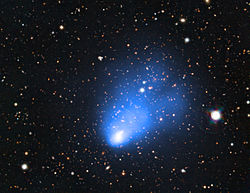| ACT-CL J0102-4915 | |
|---|---|
 El Gordo consists of two separate galaxy subclusters colliding at several million kilometres per hour. | |
| Observation data (Epoch J2000.0[1]) | |
| Constellation(s) | Phoenix |
| Right ascension | 01h 02m 52.50s[1] |
| Declination | −49° 14′ 58.0″[1] |
| Redshift | 0.87[1] |
| Other designations | |
| El Gordo,[1] ACT-CL J0102-4915,[2] SPT-CL J0102-4915[2] | |
El Gordo (lit. The Fat One) (ACT-CL J0102-4915 or SPT-CL J0102-4915) is the largest distant galaxy cluster observed at its distance or beyond, as of 2011. As of 2014, it held the record for being the largest distant galaxy cluster to have been discovered with a mass of slightly less than three quadrillion solar masses[3][4][5][6] although later its mass was reduced to about 2.1×1015 (2.1 quadrillion) solar masses with a 10% uncertainty.[7] It was found by NASA's Chandra X-ray Observatory, the Atacama Cosmology Telescope (funded by the National Science Foundation) and the European Southern Observatory's Very Large Telescope.[8]
This galaxy cluster, officially named as, 'ACT-CL J0102-4915', has been given a 'nickname' by the researchers as 'El Gordo', which stands for "the Fat One" or "the Big One" in Spanish. It is located more than 7 billion light-years from Earth.[9]
Findings and results on 'El Gordo' were announced at the 219th meeting of American Astronomical Society in Austin, Texas.[10]
Observations
[edit]Findings from the European Southern Observatory's Very Large Telescope and the Chandra X-ray Observatory show that El Gordo is composed of two separate galaxy subclusters, colliding at several million kilometers per hour.[11] These observations (using X-ray data and other characteristics) suggest that El Gordo most probably formed in the same manner as the Bullet Cluster (which is located 4 billion light-years from Earth).[12][13][14][15]
El Gordo and ΛCDM
[edit]It was claimed that this interacting cluster presents problems for the conventional Lambda-CDM model of cosmology because it is hard to reconcile ΛCDM's model of galaxy formation with the combination of how early El Gordo is observed in cosmic history, its large mass, and its high collision velocity.[16] It was argued that later more accurate measurements have rejected this claim and led to a smaller mass estimate fully consistent with the ΛCDM cosmology.[7] However, the claims of consistency with ΛCDM were shown to be due to the assumption of a very low collision velocity that is not supported by any hydrodynamical simulations, not because of the slightly reduced mass estimate, which by itself does not solve the problem.[17]
Gallery
[edit]-
Galaxy cluster ACT-CL J0102-4915 contains the mass of about two million billion suns.[18]
-
Hubble image of ACT-CL J0102-4915[19]
-
JWST image of ACT-CL J0102-4915
See also
[edit]- List of galaxy groups and clusters
- RCS2 J2327, another galaxy cluster being the second-most-massive galaxy cluster at a record of two quadrillion, or two million billion, suns.
References
[edit]- ^ a b c d e "NAME El Gordo". SIMBAD. Centre de données astronomiques de Strasbourg.
- ^ a b "SPT-CL J0102-4915". NASA/IPAC Extragalactic Database.
- ^ Guinness World Records 2014, Page 030.
- ^ Boen, Brooke; Dunbar, Brian (16 April 2014). "Monster "El Gordo" Galaxy Cluster is Bigger Than Thought". NASA. Retrieved 17 April 2014.
- ^ NASA, "El Gordo Galaxy Cluster" Archived 2012-01-13 at the Wayback Machine, 10 January 2012 (accessed 7 July 2012)
- ^ Monster NASA "Monster "El Gordo" Galaxy Cluster is Bigger Than Thought"
- ^ a b Kim, Jinhyub; Jee, M. James; Hughes, John P.; Yoon, Mijin; HyeongHan, Kim; Menanteau, Felipe; Sifón, Cristóbal; Hovey, Luke; Arunachalam, Prasiddha (2021-12-01). "Head-to-Toe Measurement of El Gordo: Improved Analysis of the Galaxy Cluster ACT-CL J0102–4915 with New Wide-field Hubble Space Telescope Imaging Data". The Astrophysical Journal. 923 (1): 101. arXiv:2106.00031. Bibcode:2021ApJ...923..101K. doi:10.3847/1538-4357/ac294f. ISSN 0004-637X.
- ^ CNN News 'Fat' galaxy cluster discovered 7 billion light-years away Archived 2017-08-16 at the Wayback Machine
- ^ "NASA's Chandra Finds Largest Galaxy Cluster in Early Universe". Archived from the original on 2017-05-01. Retrieved 2012-01-11.
- ^ Choi, Charles (January 10, 2012). "Monster Galaxy Cluster 'El Gordo' Packs Mass of 2 Quadrillion Suns". Space.com. Space.com. Retrieved April 13, 2017.
- ^ CNN News El Gordo is made up of two separate galaxy subclusters Archived 2017-08-16 at the Wayback Machine
- ^ "El Gordo: A 'fat' distant galaxy cluster".
- ^ El Gordo akin to the well-known object called the Bullet Cluster
- ^ El Gordo most probably formed just like the Blue Cluster
- ^ "El Gordo akin to the well-known object called the Bullet Cluster". Archived from the original on 2017-05-01. Retrieved 2012-01-11.
- ^ Asencio, Elena; Banik, Indranil; Kroupa, Pavel (February 2021). "A massive blow for ΛCDM – the high redshift, mass, and collision velocity of the interacting galaxy cluster El Gordo contradicts concordance cosmology". Monthly Notices of the Royal Astronomical Society. 500 (4): 5249–5267. arXiv:2012.03950. doi:10.1093/mnras/staa3441. Retrieved 7 February 2021.
- ^ Asencio, Elena; Banik, Indranil; Kroupa, Pavel (September 2023). "The El Gordo galaxy cluster challenges ΛCDM for any plausible collision velocity". The Astrophysical Journal. 954 (2): 162. arXiv:2308.00744. Bibcode:2023ApJ...954..162A. doi:10.3847/1538-4357/ace62a. ISSN 0004-637X.
- ^ "A gargantuan collision". www.spacetelescope.org. Retrieved 8 January 2018.
- ^ "Hubble weighs "the fat one"". ESA/Hubble Picture of the Week. Retrieved 10 April 2014.
![Galaxy cluster ACT-CL J0102-4915 contains the mass of about two million billion suns.[18]](http://upload.wikimedia.org/wikipedia/commons/thumb/0/0d/A_gargantuan_collision_ACT-CL_J0102-4915.jpg/120px-A_gargantuan_collision_ACT-CL_J0102-4915.jpg)
![Hubble image of ACT-CL J0102-4915[19]](http://upload.wikimedia.org/wikipedia/commons/thumb/7/78/Galaxy_Cluster_%27El_Gordo%27_with_Mass_Map.jpg/120px-Galaxy_Cluster_%27El_Gordo%27_with_Mass_Map.jpg)
